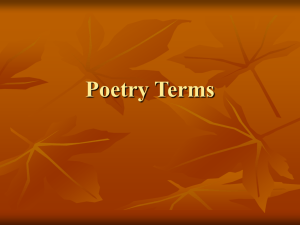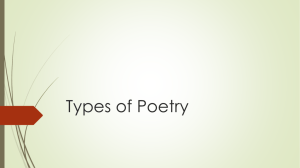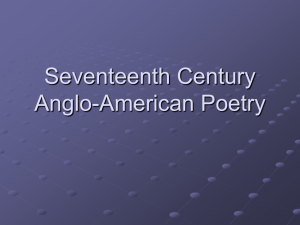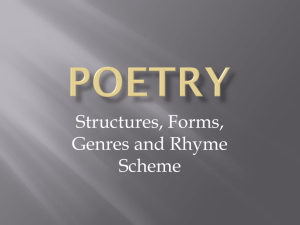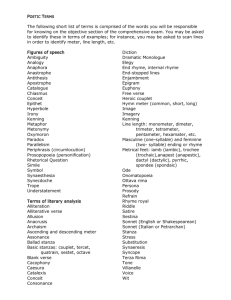Figurative Language
advertisement
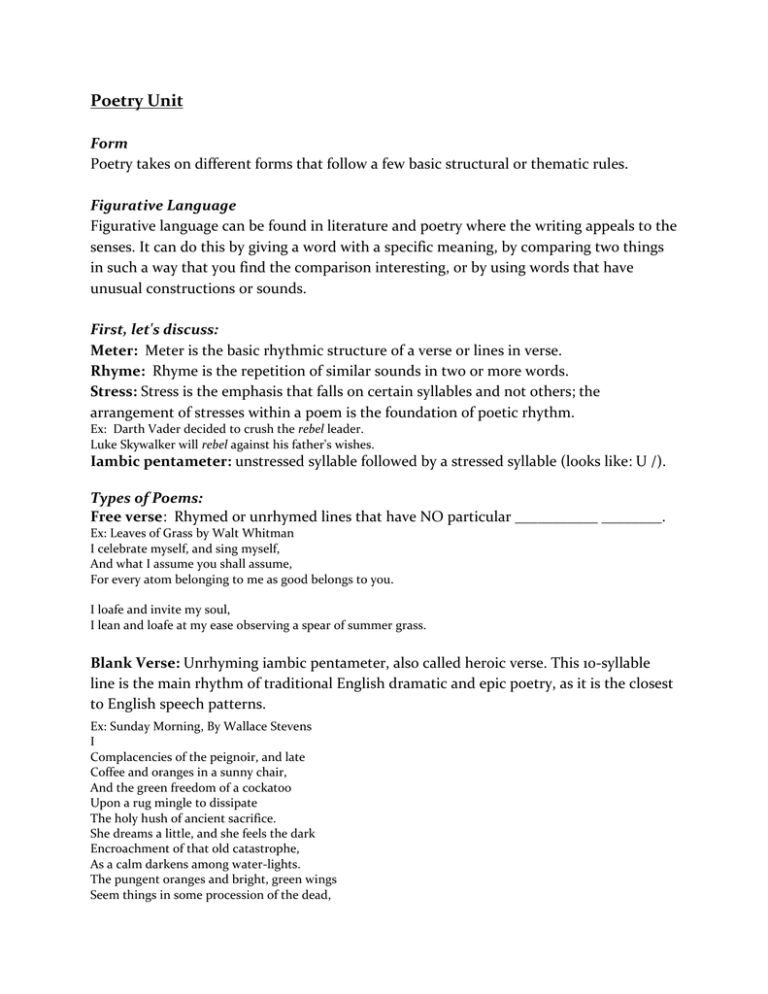
Poetry Unit Form Poetry takes on different forms that follow a few basic structural or thematic rules. Figurative Language Figurative language can be found in literature and poetry where the writing appeals to the senses. It can do this by giving a word with a specific meaning, by comparing two things in such a way that you find the comparison interesting, or by using words that have unusual constructions or sounds. First, let's discuss: Meter: Meter is the basic rhythmic structure of a verse or lines in verse. Rhyme: Rhyme is the repetition of similar sounds in two or more words. Stress: Stress is the emphasis that falls on certain syllables and not others; the arrangement of stresses within a poem is the foundation of poetic rhythm. Ex: Darth Vader decided to crush the rebel leader. Luke Skywalker will rebel against his father's wishes. Iambic pentameter: unstressed syllable followed by a stressed syllable (looks like: U /). Types of Poems: Free verse: Rhymed or unrhymed lines that have NO particular ___________ ________. Ex: Leaves of Grass by Walt Whitman I celebrate myself, and sing myself, And what I assume you shall assume, For every atom belonging to me as good belongs to you. I loafe and invite my soul, I lean and loafe at my ease observing a spear of summer grass. Blank Verse: Unrhyming iambic pentameter, also called heroic verse. This 10-syllable line is the main rhythm of traditional English dramatic and epic poetry, as it is the closest to English speech patterns. Ex: Sunday Morning, By Wallace Stevens I Complacencies of the peignoir, and late Coffee and oranges in a sunny chair, And the green freedom of a cockatoo Upon a rug mingle to dissipate The holy hush of ancient sacrifice. She dreams a little, and she feels the dark Encroachment of that old catastrophe, As a calm darkens among water-lights. The pungent oranges and bright, green wings Seem things in some procession of the dead, Winding across wide water, without sound. The day is like wide water, without sound, Stilled for the passing of her dreaming feet Over the seas, to silent Palestine, Dominion of the blood and sepulchre. Limerick: Short, sometimes humorous poems consisting of 5 lines. Lines 1, 2, and 5 have seven to ten syllables and _________. Lines 3 and 4 have ________ to ________ syllables and also rhyme with each other. Ex: Limerick from The Book of Nonsense (1800's) By Edward Lear There was an Old Man with a gong Who bumped it all day long; But they called out, 'O law! You're a horrid old bore! So they smashed that Old Man with a gong. English Sonnet: English (or____________________) sonnets are lyric poems that are 14 lines long, falling into ___________ coordinating quatrains and a concluding __________. Quatrain: A __________ or complete poem consisting of 4 lines of verse. Couplet: A __________ of lines of meter in poetry. Usually these two lines __________ and have the same meter. Ex: Sonnet 130, William Shakespeare My mistress’ eyes are nothing like the sun; Coral is far more red than her lips’ red; If snow be white, why then her breasts are dun; If hairs be wires, black wires grow on her head. I have seen roses damasked, red and white, But no such roses see I in her cheeks; And in some perfumes is there more delight Than in the breath that from my mistress reeks. I love to hear her speak, yet well I know That music hath a far more pleasing sound; I grant I never saw a goddess go; My mistress when she walks treads on the ground. And yet, by heaven, I think my love as rare As any she belied with false compare. Petrarchan Sonnet: Perfected by the Italian poet Petrarch, divides the 14 lines into two sections: an eight-line stanza (________) rhyming ABBAABBA, and a six-line stanza (_________) rhyming CDCDCD or CDEEDE. Sestet: A six-line stanza, or the final six lines of a 14-line Italian or Petrarchan sonnet. Octave: The first eight lines of an Italian or Petrarchan sonnet Spenserian Sonnet: 14-line poem developed by Edmund Spenser in his Amoretti, that varies the English form by _______________ the three quatrains (ABAB BCBC CDCD EE). Haiku: Haiku poetry form originated in _____________. It is composed of three unrhymed lines of five, ___________, and five syllables. By Basho An old silent pond A frog jumps into the pond, splash! Silence again. Haikus are easy But sometimes they don't make sense Refrigerator Ballad: Ballad poems tell a story. They are similar to a folk tale or _____________ and often have a __________ refrain. A ballad is often about _________ and sometimes sung. A ballad is a story in poetic form. Ex: Second Ballad (to the tune of "Davy the Dicer") Long was I, Lady Luck, your serving-man, And now have lost again all that I gat; When, therefore, I think of you now and then, And in my mind remember this and that, Ye may not blame me, though I shrew your cat; In faith I bless you, and a thousand times, For lending me some leisure to make rhymes. Epic: Epic poems are long, serious poems that tell the story of a heroic figure. Some other most famous epic poems are "The Iliad," and "The Odyssey" by Homer. Ex: BEOWULF (look familiar??): The Geat prince went for Grendel’s mother, seized her by the shoulder he was not sorry to be fighting his mortal foe and with mounting anger the man hard in battle hurled her to the ground. Elegy: In traditional English poetry, it is often a melancholy poem that _________ its subject’s death but ends in ___________. Ode: A formal, often ceremonious lyric poem that addresses and often celebrates a person, place, thing, or idea. Its stanza forms vary. Pastoral: "Pastoral" (from pastor, Latin for "shepherd") refers to a literary work dealing with shepherds and rustic life. Pastoral poetry presents an idealized (perfect) rather than realistic view of rustic life. Figurative Language: Similes and Metaphors: Similes - comparing two things using "like" or "as" ("as brave as a lion" and "crazy like a fox"). Metaphors - a comparison in which one thing is said to be another (Princess Leia is a goddess. Chewbacca is a giant teddy bear). Personification: Giving human characteristics to an animal, object, or abstract quality (The sun played hide and seek with the clouds). Repetition: a literary device that repeats the same words or phrases a few times to make an idea clearer. Hyperbole: an exaggerated statement usually not meant to be taken seriously but to help make a point. Oxymoron: a combination of words or ideas that have opposing meanings. Onomatopoeia: describes noises or sounds written like sound effects, spelled the way that they sound. Alliteration: the repeating sounds of a letter or word. Cacophony: refers to the use of words that combine sharp, harsh, hissing, or unmelodious sounds. Euphony: refers to pleasant spoken sound that is created by smooth consonants. Slant Rhyme: (also called half-rhyme or lazy rhyme) a type of rhyme formed by words with similar but not identical sounds. Rhythm: A noticeable pattern in verse established by the pauses between stressed syllables. Assonance: The repetition of vowel sounds without repeating consonants; sometimes called vowel rhyme. Consonance: A resemblance in sound between two words, or an initial rhyme. Consonance can also refer to shared consonants, whether in sequence (“bed” and “bad”) or reversed (“bud” and “dab”). Refrain: A phrase or line repeated at intervals within a poem, especially at the end of a stanza. Allusion: A reference to something in history or current culture (“He was as crazy as the narrator of The Tell-Tale Heart”—who is this? Or “this place looks like the Garden of Eden”). Imagery: is the formation of mental images, figures, or likenesses through writing. Internal Rhyme: rhyming that occurs WITHIN lines of verse. End Rhyme: rhyming that occurs at the END of lines of verse.
